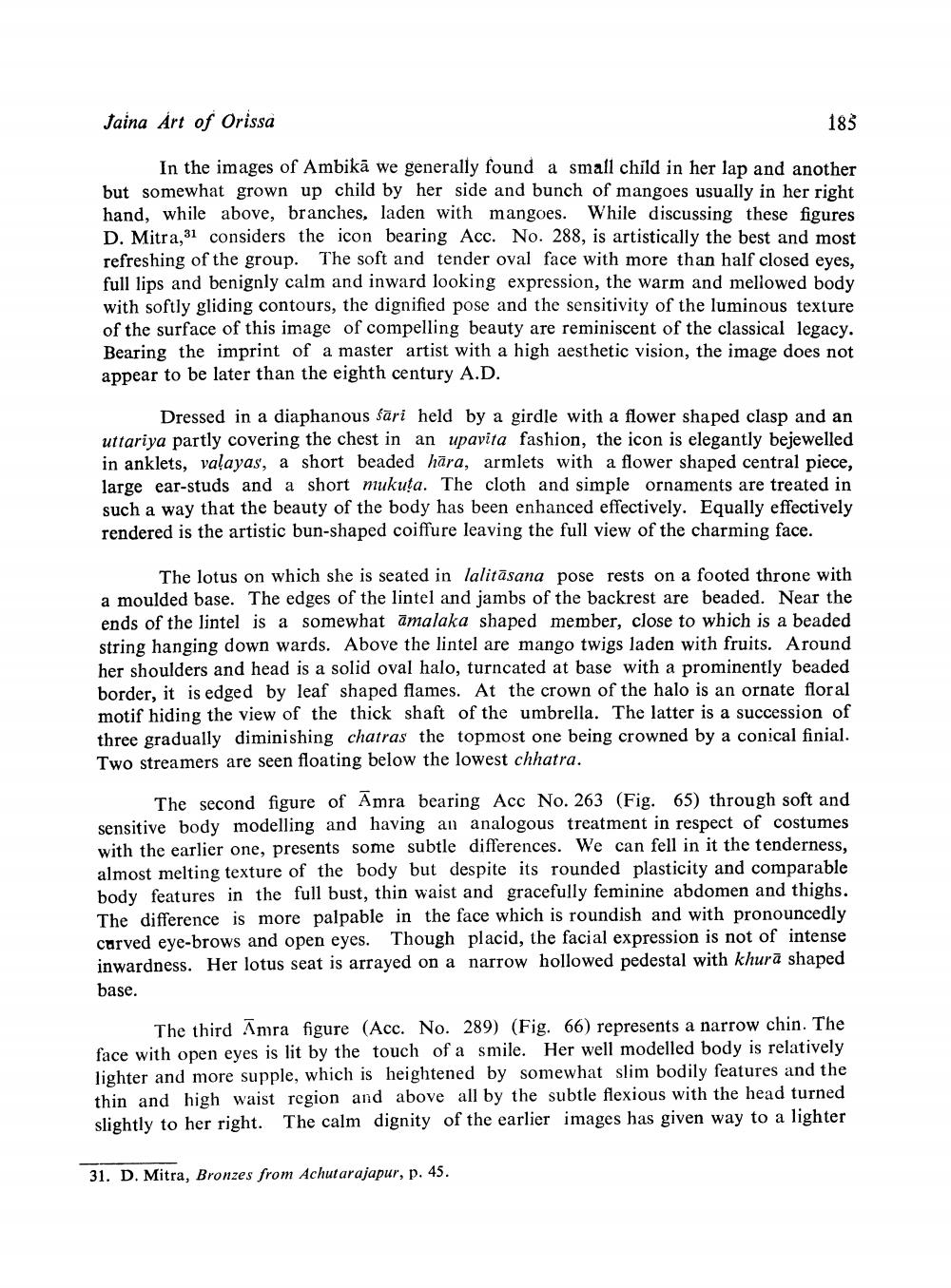________________
Jaina Árt of Orissa
183
In the images of Ambikā we generally found a small child in her lap and another but somewhat grown up child by her side and bunch of mangoes usually in her right hand, while above, branches, laden with mangoes. While discussing these figures D. Mitra, 31 considers the icon bearing Acc. No. 288, is artistically the best and most refreshing of the group. The soft and tender oval face with more than half closed eyes, full lips and benignly calm and inward looking expression, the warm and mellowed body with softly gliding contours, the dignified pose and the sensitivity of the luminous texture of the surface of this image of compelling beauty are reminiscent of the classical legacy. Bearing the imprint of a master artist with a high aesthetic vision, the image does not appear to be later than the eighth century A.D.
Dressed in a diaphanous śāri held by a girdle with a flower shaped clasp and an uttariya partly covering the chest in an upavita fashion, the icon is elegantly bejewelled in anklets, valayas, a short beaded hāra, armlets with a flower shaped central piece, large ear-studs and a short mukuta. The cloth and simple ornaments are treated in such a way that the beauty of the body has been enhanced effectively. Equally effectively rendered is the artistic bun-shaped coiffure leaving the full view of the charming face.
The lotus on which she is seated in lalitāsana pose rests on a footed throne with a moulded base. The edges of the lintel and jambs of the backrest are beaded. Near the ends of the lintel is a somewhat āmalaka shaped member, close to which is a beaded string hanging down wards. Above the lintel are mango twigs laden with fruits. Around her shoulders and head is a solid oval halo, turncated at base with a prominently beaded border, it is edged by leaf shaped flames. At the crown of the halo is an ornate floral motif hiding the view of the thick shaft of the umbrella. The latter is a succession of three gradually diminishing chatras the topmost one being crowned by a conical finial. Two streamers are seen floating below the lowest chhatra.
The second figure of Amra bearing Acc No. 263 (Fig. 65) through soft and sensitive body modelling and having an analogous treatment in respect of costumes with the earlier one, presents some subtle differences. We can fell in it the tenderness, almost melting texture of the body but despite its rounded plasticity and comparable body features in the full bust, thin waist and gracefully feminine abdomen and thighs. The difference is more palpable in the face which is roundish and with pronouncedly curved eye-brows and open eyes. Though placid, the facial expression is not of intense inwardness. Her lotus seat is arrayed on a narrow hollowed pedestal with khurā shaped base.
The third Amra figure (Acc. No. 289) (Fig. 66) represents a narrow chin. The face with open eyes is lit by the touch of a smile. Her well modelled body is relatively lighter and more supple, which is heightened by somewhat slim bodily features and the thin and high waist region and above all by the subtle flexious with the head turned slightly to her right. The calm dignity of the earlier images has given way to a lighter
31. D. Mitra, Bronzes from Achutarajapur, p. 45.




